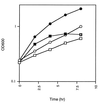Exponential-phase glycogen recycling is essential for growth of Mycobacterium smegmatis
- PMID: 10542168
- PMCID: PMC94131
- DOI: 10.1128/JB.181.21.6670-6678.1999
Exponential-phase glycogen recycling is essential for growth of Mycobacterium smegmatis
Abstract
Bacterial glycogen is a polyglucose storage compound that is thought to prolong viability during stationary phase. However, a specific role for glycogen has not been determined. We have characterized SMEG53, a temperature-sensitive mutant of Mycobacterium smegmatis that contains a mutation in glgE, encoding a putative glucanase. This mutation causes exponentially growing SMEG53 cells to stop growing at 42 degrees C in response to high levels of glycogen accumulation. The mutation in glgE is also associated with an altered growth rate and colony morphology at permissive temperatures; the severity of these phenotypes correlates with the amount of glycogen accumulated by the mutant. Suppression of the temperature-sensitive phenotype, via a decrease in glycogen accumulation, is mediated by growth in certain media or multicopy expression of garA. The function of GarA is unknown, but the presence of a forkhead-associated domain suggests that this protein is a member of a serine-threonine kinase signal transduction pathway. Our results suggest that in M. smegmatis glycogen is continuously synthesized and then degraded by GlgE throughout exponential growth. In turn, this constant recycling of glycogen controls the downstream availability of carbon and energy. Thus, in addition to its conventional storage role, glycogen may also serve as a carbon capacitor for glycolysis during the exponential growth of M. smegmatis.
Figures





References
-
- Antoine A D, Tepper B S. Characterization of glycogens from mycobacteria. Arch Biochem Biophys. 1969;134:207–213. - PubMed
-
- Antoine A D, Tepper B S. Environmental control of glycogen and lipid content of Mycobacterium phlei. J Gen Microbiol. 1969;55:217–226. - PubMed
-
- Baltz R H. Mutagenesis in Streptomyces spp. In: Demain A L, Soloman N A, editors. Manual of industrial microbiology and technology. Washington, D.C.: American Society for Microbiology; 1986. pp. 184–190.
Publication types
MeSH terms
Substances
Associated data
- Actions
- Actions
Grants and funding
LinkOut - more resources
Full Text Sources
Molecular Biology Databases

